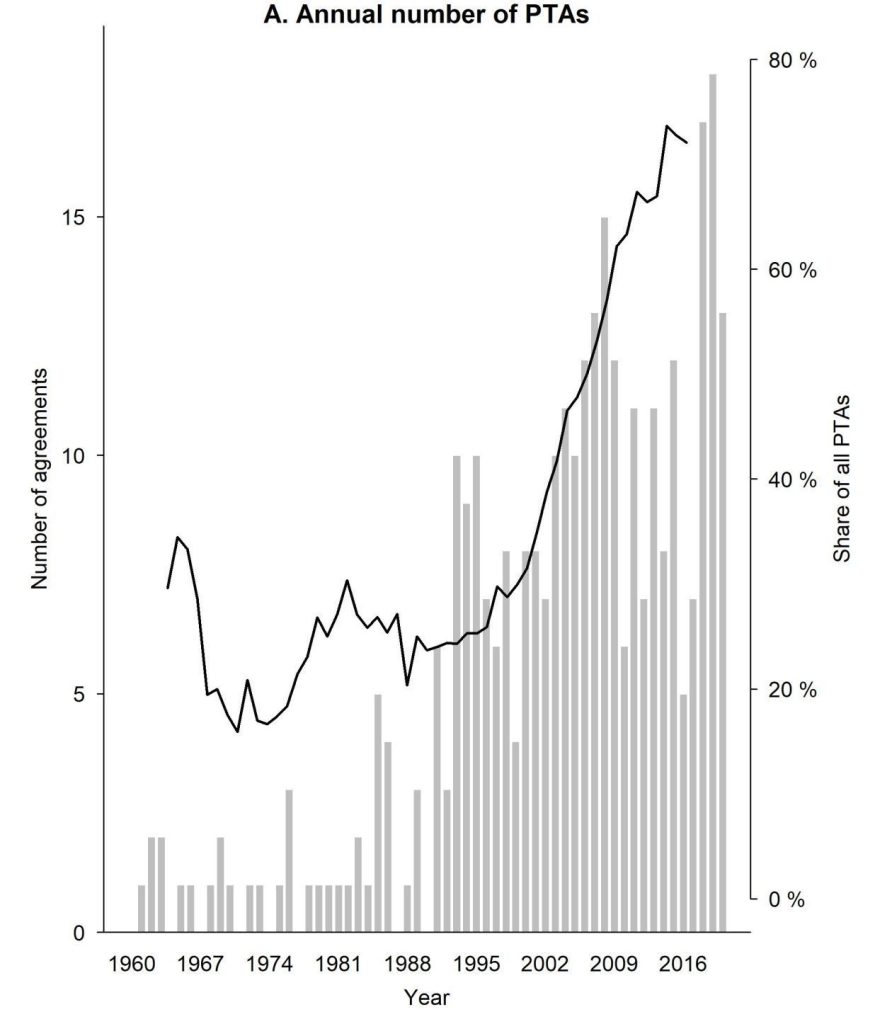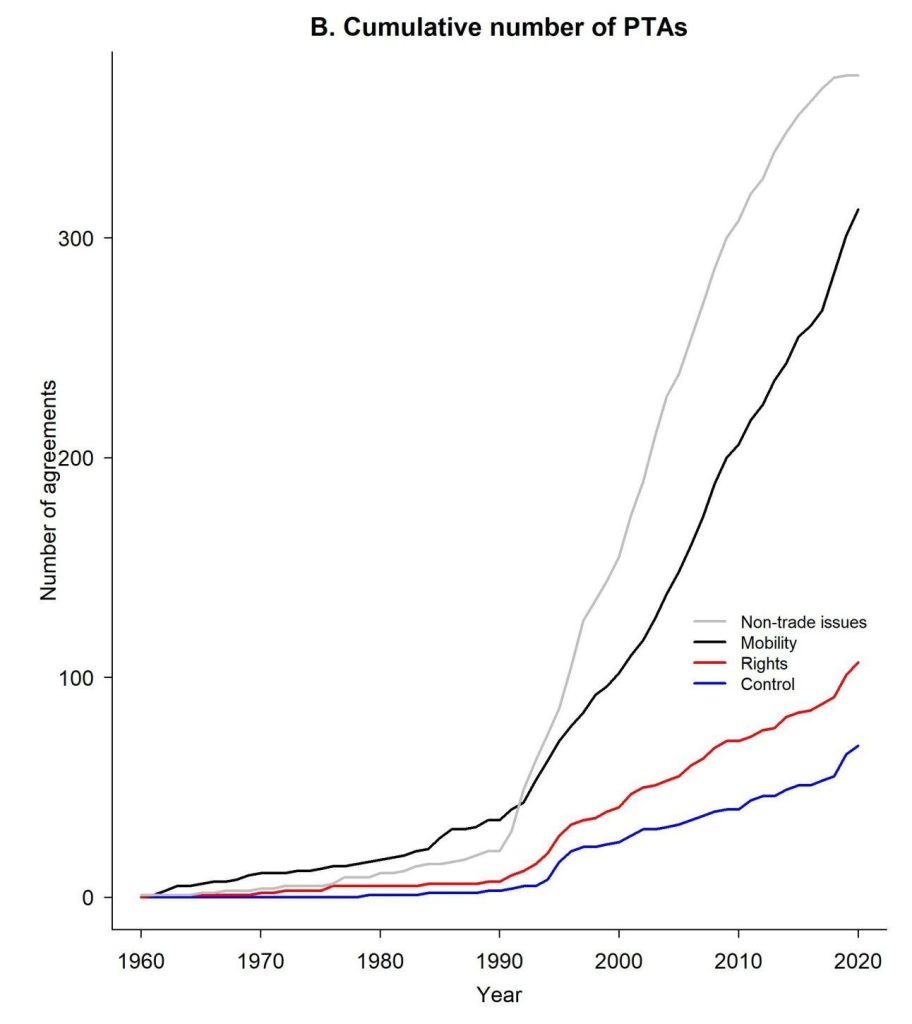
Read more
Blog, Migration Governance
Why Canada is Facing an Exodus of Skilled Migrants
The recent study conducted by the Institute for Canadian Citizenship in 2022 sheds light on a disconcerting trend among new immigrants, suggesting a potential decline in their enthusiasm for Canada compared to previous decades....
Preferential trade agreements (PTAs) aim to facilitate trade between two or more countries by doing things such as cutting tariffs or facilitating investment, but new research from the University of Geneva shows that that more than 70% of all PTAs signed in the last decade also contain provisions on international migration. The majority of these provisions are legally binding commitments that liberalize economic migration. However, states and economic blocs like the European Union also use PTAs for commitments to protect migrant rights and, especially for the EU, commitments in which the signing parties agree to fight irregular migration and cooperate on readmission.
A new dataset documenting the trade-migration nexus
These insights stem from the recently published MITA dataset that codes the complete migration policy content of PTAs signed worldwide between 1960 and 2020, which includes 236 different variables for a total of 797 agreements. The data documents the use of trade agreements for migration governance and yields a number of unexpected findings. Contrary to the widely held assumption that states’ resist tying their hands to legally binding international commitments on migration, more than 300 PTAs contain provisions facilitating the mobility of economic migrants. Provisions abolishing immigration barriers such as economic needs tests or numerical quotas or clauses that facilitate visa procedures and the recognition of qualifications have proliferated in particular since the 1990s after the adoption of similar measures in the 1995 General Agreement on Trade in Services of the WTO (so-called GATS mode 4 liberalization) (see Figure 1).
Figure 1: The evolution of migration provisions in PTAs
A tool of selective liberalization
These provisions do not apply to economic migrants in general, but usually only apply to narrowly defined categories of people, mostly linked to trade in services. The most common categories are Intra-Corporate Transferees (ICTs), business visitors, contractual service suppliers (that is, the international equivalent to posted workers in the EU), and independent professionals. And most of these have to be highly skilled, although some PTAs also facilitate the migration of trainees or nurses. The most interesting caveat of this rapidly expanding venue for economic migration is that the vast majority of PTAs exclude access to the labour market.
How does this work? In fact, trade and migration practitioners avoid speaking of “migration” in the context of PTAs and prefer to use the term “mode 4 mobility”. The trick is that these persons formally retain their work contract in the country they come from. However, their mobility qualifies well as migration, as their allocated duration of stay can reach from a few months to five years or more in the case of ICT.
Now, one could assume that this kind of migration is not politically sensitive, but votes in the US congress and UK debates regarding the inclusion of migration in post-Brexit trade agreements show that these provisions can be thorny issues both in negotiations between lawmakers and in the eye of the public. Furthermore, while publicly available migration statistics usually do not allow us to identify posted migrants among labour migrants, first analyses in the UK and Switzerland show that internationally posted workers including ICTs can account for as many as 40% of all non-EU/EFTA economic migrants in a given year.
Thus rather than being a sweeping liberalization, mobility provisions in PTAs reinforce particular trends in immigration policies:
- an increasing differentiation between wanted and unwanted types of migrants, and
- the regulation of migration via a ‘market model’ that emphasizes temporary stays to reap human capital while minimizing settlement in the host society.
Migrant rights and migration control as non-trade issues
Compared with mobility provisions, migrant rights and migration control provisions figure less frequently in PTAs (see Figure 1 above). This is not surprising as they are not directly linked to trade transactions. Our analysis shows that the migrant rights provisions in trade agreements mirror clauses codified in Conventions by the International Labour Organization and in the 1990 UN Migrant Workers Convention—based on demands by sending countries for a non-discriminatory treatment of their workers and the portability of social security benefits. Contrary to mobility provisions, migrant rights have not become deeper over time and even show a trend towards shallowing out. This also echoes the low level of ratification we find for the international conventions on migrant rights.
The most strategic type of migration provision in PTAs relates to migration control. Commitments on fighting irregular migration and migrant readmission are strategic because they are the result of an issue-linkage whereby one party instrumentalises a trade policy instrument to get concessions from the other party on a different matter that is disconnected to trade, in our case migration control. True to its reputation as ‘market power’, our findings show that it is practically only EU PTAs that include clauses to enforce migration control.
No escape from the immigration dilemma
To conclude, the MITA dataset yields new insights in the politics and policies regulating economic migration, migrant rights and migration control all over the world since 1960 – from an international relations, (comparative) regional integration or domestic and comparative politics perspective. Our analysis suggests that PTA provisions tend to confirm – rather than alleviate – the collective action problems that render migration policy contested within and between states.
And this is just the beginning of what MITA can show us. Using MITA, scholars can also investigate the interplay between states’ cooperation via PTAs and other international venues and ask how far their PTA provisions expand, complement or substitute multilateral institutions. Finally, MITA allows scholars to investigate further the drivers and constraints of states’ policies regarding economic migration, migrant rights or migration control – and to examine the interplay between what states do via PTAs and other venues of migration policy-making such as domestic legislation or other bilateral and multilateral agreements.
Note: this research was supported by the ‘nccr-on the move’ funded by the Swiss National Science Foundation grant 51NF40-182897. We are grateful to Julia Gubler and Laura Mauricio for their excellent research assistance in the coding of migration provisions.
About the authors:
Sandra Lavenex is a professor of European and international politics at the University of Geneva and a visiting professor at the College of Europe.
Philipp Lutz is a senior researcher at the University of Geneva and an assistant professor of political science at the Vrije Universiteit Amsterdam.
Paula Hoffmeyer‐Zlotnik is a research fellow at the Cologne Center for Comparative Politics, a PhD candidate at the University of Geneva, and a former visiting fellow at the Migration Policy Centre.



